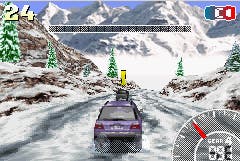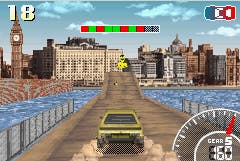Stuntman
Atari 'actions' a GBA port of Reflections' PS2 smash.
Stuntman had all the makings of a truly exceptional game, but in the end fell down due to its overly exacting linear gameplay, and - most crucially - the poor load times which meant that you'd spend more time looking at the loading screen than actually playing the damn thing.
The basic premise in the Career mode is that you are a stuntman for hire, trying to make your way up the ladder from low budget flicks, through to Hollywood blockbusters. Each of the six 'films' is made up of a series of 'scenes' and it's up to you to follow the director's orders and prove that you have what it takes. As you progress you get better (or more interesting) vehicles to drive, and more outlandish big budget stunts to perform. The other mode, Arena, is pretty much identical in gameplay terms to the Career mode, except it's based in a stadium instead.
A 'smash' hit

The basic concept for Stuntman is great, but the execution is something else entirely. You're effectively given a limited amount of time in which to perform at least 50 per cent of the stunts laid out for you, such as smashing boxes, passing through narrow gaps, performing jumps or triggering explosions. The real hindrance, though, is that you can't deviate off route and you must reach the next checkpoint before the counter ticks down. Something that's easier said than done.
The problem everyone encounters in Stuntman is that they naturally want to go off route. They want to maybe see if there's a shortcut, and they'll certainly come a cropper with that blessed time limit. It quickly becomes clear that the only route to success is to treat the game as a 'memorise 'em up' as you have to learn each course intimately before you can get to try out the next scene. On the PS2 original, this crippled the enjoyment factor as the aforementioned loading time problems made it immensely frustrating, which was a crying shame as the game was actually incredibly addictive.
On the GBA, however, there are no loading times, because it's a cartridge not a CD, and thus Stuntman becomes a far less frustrating game as a result.
Miracle men

There are trade offs, naturally. The graphics and excellent physics of the original are never realistically going to make it to the humble environs of the GBA, but the development team of Fernando Velez and Guillaume Dubail have performed near miracles to do a decent approximation.
Visually, Stuntman's are easily among the most ambitious on the platform, pumping out highly detailed, well designed and varied 3D play areas that have been redesigned specifically for the GBA. Add to that a decent amount of detail on the vehicles, and a decent frame rate to match and it's an impressive looking title. There are drawbacks, however.
The first such oddity is the bizarre mission briefings, which are introduced with a disturbingly zombiefied 3D head (why oh why?), and within seconds of commencing the game you'll witness some extremely odd things happening which conspire to spoil the overall quality on show. Chief amongst such oddities is the way the walls warp whenever you happen to drive near them, or trains appearing despite being obscured by an entire mountain range. These are things so fundamentally bad you have to wonder how on earth Atari ever approved such an obviously unfinished engine in the first place. It doesn't particularly detract from the gameplay, but that's hardly the point.
I said smash the boxes you complete idiot!

Happily, the audio's also pretty decent, especially considering the platform limitations. Not only does the director bark orders at you during the game, with clear, well-sampled speech, but explosions, screeching tyres and even the soundtrack are well above par. Shame about the hairdryer engine sounds, though.
Meanwhile, the handling is much more basic than the spongy physics used in the PS2 version, and it probably makes it an altogether more playable game as a result. 180 degree handbrake turns, for example, can be pulled off with a quick tap of the R button, and negotiating the course feels a lot easier thanks to much more solid and precise handling. Rather than it taking 20 or more attempts per scene, as on the PS2 version, you can probably lick most of the GBA levels in less than half the time - which is somewhere within the bounds of sanity, and no doubt an attempt at appeasing the younger audience. The difficulty does ramp up, naturally, but you're never left feeling too frustrated thanks to the ability to start all over again immediately.
After the howls of dissent thrust at the PS2 version we're left wondering whether anyone will care to spend £35 of their hard earned cash on this. It's actually one of the better GBA games around, believe it or not, but given that it's arrived nearly 11 months after the original, it's selling to an audience which has long since moved on, and probably harbours a grudge against the game.








